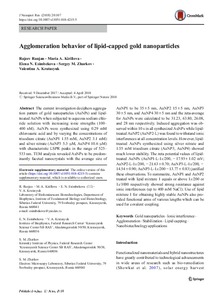Показать сокращенную информацию
Agglomeration behavior of lipid capped gold nanoparticles
| Автор | Ranjan, R. | |
| Автор | Kirillova, M. A. | |
| Автор | Esimbekova, E. N. | |
| Автор | Жарков, Сергей Михайлович | |
| Автор | Kratasyuk, V. A. | |
| Дата внесения | 2019-07-01T07:28:47Z | |
| Дата, когда ресурс стал доступен | 2019-07-01T07:28:47Z | |
| Дата публикации | 2018-04 | |
| Библиографическое описание | Ranjan, R. Agglomeration behavior of lipid capped gold nanoparticles [Текст] / R. Ranjan, M. A. Kirillova, E. N. Esimbekova, Сергей Михайлович Жарков, V. A. Kratasyuk // Journal of Nanoparticle Research. — 2018. — Т. 20 (№ 4). — С. 107-11 | |
| ISSN | 13880764 | |
| URI (для ссылок/цитирований) | https://link.springer.com/article/10.1007/s11051-018-4215-5 | |
| URI (для ссылок/цитирований) | https://elib.sfu-kras.ru/handle/2311/111224 | |
| Описание | Текст статьи не публикуется в открытом доступе в соответствии с политикой журнала. | |
| Аннотация | The current investigation deciphers aggregation pattern of gold nanoparticles (AuNPs) and lipidtreated AuNPs when subjected to aqueous sodium chloride solution with increasing ionic strengths (100– 400 nM). AuNPs were synthesized using 0.29 mM chloroauric acid and by varying the concentrations of trisodium citrate (AuNP1 1.55 mM, AuNP2 3.1 mM) and silver nitrate (AuNP3 5.3 μM, AuNP4 10.6 μM) with characteristic LSPR peaks in the range of 525– 533 nm. TEM analysis revealed AuNPs to be predominantly faceted nanocrystals with the average size of AuNP1 to be 35 ± 5 nm, AuNP2 15 ± 5 nm, AuNP3 30 ± 5 nm, and AuNP4 30 ± 5 nm and the zeta-average for AuNPs were calculated to be 31.23, 63.80, 26.08, and 28 nm respectively. Induced aggregation was observed within 10 s in all synthesized AuNPs while lipidtreated AuNP2 (AuNP2-L) was found towithstand ionic interferences at all concentration levels. However, lipidtreated AuNPs synthesized using silver nitrate and 1.55 mM trisodium citrate (AuNP3, AuNP4) showed much lower stability. The zeta potential values of lipidtreated AuNPs (AuNP1-L-1x/200, − 17.93 ± 1.02 mV; AuNP2-L-1x/200, − 21.63 ± 0.70; AuNP3-L-1x/200, − 14.54 ± 0.90; AuNP3-L-1x/200 − 13.77 ± 0.83) justified these observations. To summarize, AuNP1 and AuNP2 treated with lipid mixture 1 equals or above 1x/200 or 1x/1000 respectively showed strong resistance against ionic interferences (up to 400 mM NaCl). Use of lipid mixture 1 for obtaining highly stable AuNPs also provided functional arms of various lengths which can be used for covalent coupling. | |
| Тема | Gold nanoparticles | |
| Тема | Ionic interference | |
| Тема | Agglomeration | |
| Тема | Stabilization | |
| Тема | Lipid capping | |
| Тема | Nanobiotechnology applications | |
| Название | Agglomeration behavior of lipid capped gold nanoparticles | |
| Тип | Journal Article | |
| Тип | Published Journal Article | |
| Страницы | 107-11 | |
| ГРНТИ | 29.19.22 | |
| Дата обновления | 2019-07-01T07:28:47Z | |
| DOI | 10.1007/s1105 | |
| Институт | Политехнический институт | |
| Институт | Институт фундаментальной биологии и биотехнологии | |
| Подразделение | Кафедра материаловедения и технологии обработки материалов | |
| Подразделение | Кафедра биофизики | |
| Журнал | Journal of Nanoparticle Research | |
| Квартиль журнала в Scopus | Q2 | |
| Квартиль журнала в Web of Science | Q2 |

